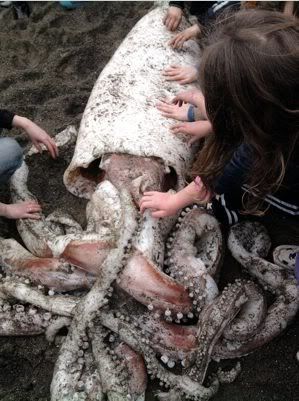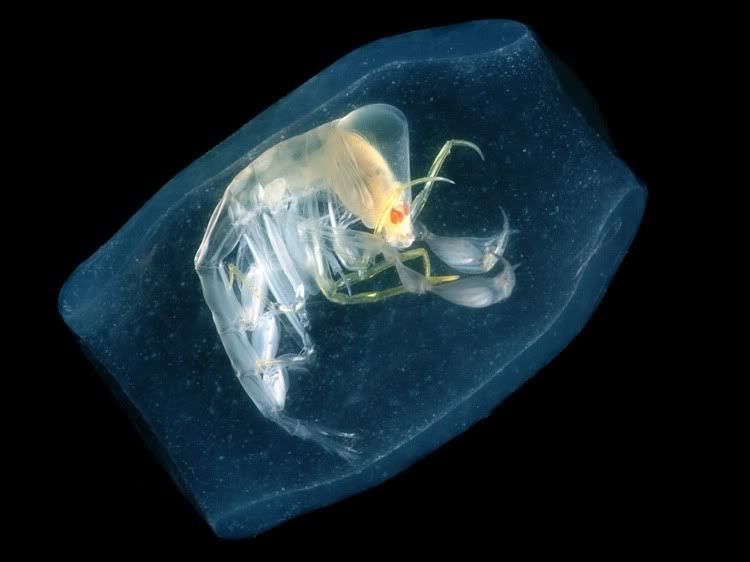Sunday, August 8, 2010
Sunday Spinelessness - In the news
Spineless creatures have been all over the news this week. We've had strange beasts appearing on beaches, wondrous finds from the deeps and (apparently) a new front on the war on cancer.
Let's start here in New Zealand with a surprising find on a Wellington beach.

Photo from stuff article /Emma Best
That's a giant squid (Architeuthis sp.) and at 3m long it's a baby, full grown females can reach 13m. Giant squids are really deep sea predators, so beachings are relatively rare. This one appears to have been in a fight. We don't know too much about the food webs at the bottom of the ocean, sperm whales are the only creatures known to take on adult giant squids but sharks and other whales might very well attack sub adults like this one. As an aside, studying parasites might be the best way to work out who eats who in the deeps. When you dissect a shark or a whale its stomach contents give you a picture of what it's eaten recently, when you look at its parasites you can paint a picture of what it's eaten over its lifetime. However the squid got its injuries, they proved fatal. it washed up dead and was returned to the ocean with the next high tide.
Then there was the announcement of the results of the Census of Marine Life, an inventory of the species living in the earth's oceans. The news of that story was almost universally illustrated with pretty pictures of weird animals photographed from deep sea submersibles. Here's a particularly striking example of the genre, an amphipod with a house which showed up in the Guardian and National Geographic:

Photo from Texas A&M press
Obviously, that mean-looking shrimp-like amphipod is a spineles creature, but it might suprise you that its transluscent home is also an animal. In fact, it's one of your closest relatives in the biological world. It's a salp, a relative of the sea squirts, and it's a member of the chordata - the same phylum as the all the vertebrates. Matt Cobb has all the details in his guest post at why Evolution is True.
Finally, scientists published the first complete genome sequence from a sponge. As has become customary for genome studies, the press releases and the resulting new stories all suggest that these DNA sequences will help us fight cancer. Well, perhaps. Cancer is ultimately about uncontrolled cell proliferation and sponges are the simplest animals to have to find a way of marshalling thousands of cells into a single body. But is that really the only reason we should be exciting about a tool that helps us to understand the origins of multicellularity, or being able to see where the precursors of the development programs that pattern the bodies of more complex animals came from? I'd like to think the average reader is just an excited by a little scientific awe as they are by some ill defined and far off medical benefit. (Before I sound too grumpy I should say that the press release from UC Santa Barbara was really very good, it's just a shame some of those points didn't get picked up in the reporting.)
To those three stories you can add a call for insects to replace red meat, sub zero octopus venom and a BBC tour of invertebrate collections form the Gulf of Mexico. It really was quite the week for invertebrate news.
Labels: carnivorous sponge, crustacean, genomics, molluscs, porifera, salp, sci-blogs, squid, sunday spinelessness


